When we behold a wide, turf-covered expanse, we should remember that its smoothness, on which so much of its beauty depends, is mainly due to all the inequalities having been slowly levelled by worms. It is a marvellous reflection that the whole of the superficial mould over any such expanse has passed, and will again pass, every few years through the bodies of worms. The plough is one of the most ancient and most valuable of man’s inventions; but long before he existed the land was in fact regularly ploughed by earthworms – Charles Darwin
Charles Darwin is one of the greatest scientists that ever lived. His evolutionary theory opened up a whole new world of scientific understanding. But he was also a meticulous observer of some of the smallest, and seemingly insignificant, elements of the natural world – worms.
Earthworms were one of his long-term interests. So much so that in 1881, the year before his death, he wrote a book – “The formation of vegetable mould through the action of worms, with observations on their habits”. The book (which, for ease, I’ll refer to as Worms) brought together many decades of observation, experimentation, and theorising. It sold phenomenally well (thousands of copies within weeks of publication) perhaps because of its quirky topic or due to the growing interest in gardening at that time.

This article is part of Conversation Insights
The Insights team generates long-form journalism derived from interdisciplinary research. The team is working with academics from different backgrounds who have been engaged in projects aimed at tackling societal and scientific challenges.
In Worms, Darwin wrote that: “It may be doubted if there are many other animals which have played such an important part in the history of the world as these lowly organised creatures.” Quite a statement.
But Worms totally changed the public perception of this group of animals, as it looked at what we now call earthworm ecology and explored their potential intelligence. I obtained a secondhand copy of Worms 30 years ago and was inspired to begin a journey that would take me to the very places where Darwin’s observations were made.
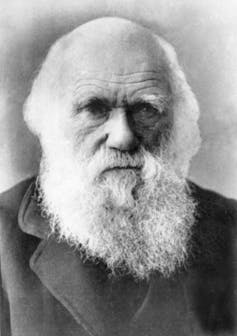
To the casual observer, earthworms and soil may seem boring at first, but they are crucial to life on this planet. As the journalist and ecologist George Monbiot wrote: “Beneath our feet is an ecosystem so astonishing that it tests the limits of our imagination. It’s as diverse as a rainforest or a coral reef. We depend on it for 99% of our food, yet we scarcely know it. Soil.”
And the guardians of the soil are the earthworms; their importance is not to be underestimated. As ecosystem service providers, earthworms perform vital activities such as soil formation and enrichment, by passing mineral components and organic matter through their guts to produce castings, a fine intimately mixed soil crumb structure, ideal for plant growth.
Without earthworms, plants wouldn’t grow in many soils, or their growth would be restricted. Earthworms also allow aeration of the soil through their burrowing, something vital to plant roots and other soil organisms.

Equally, as ecosystem engineers, earthworms change the environment in which they live to suit their everyday requirements. The scale at which earthworms operate means that their ecosystem engineering activities went unnoticed for millennia but were highlighted and initially quantified by Darwin.
I was lucky enough to have a career as an ecologist and have even repeated some of Darwin’s earthworm research in his own “back garden” within the grounds of Down House in Kent over the past 20 years.
My investigations have helped me understand just what a great scientist Darwin was, and just how amazing worms are. Indeed, I was even inspired to write my own book, Worm.
But my extensive research also reminded me of an often overlooked ecologist who was carrying out experiments about a century before Darwin – someone who Darwin knew of but declined to give proper credit to. That man was a country clergyman called Gilbert White.
The findings of both White and Darwin are now fully appreciated by earthworm ecologists, but the writings of the latter in Worms have overshadowed the lesser-known and almost hidden account of White.
Who was Gilbert White?
White was not a trained scientist. He was a country clergyman from Hampshire. But he made extensive observations of the natural world back in the 1770s.

Rather than study dead specimens, as many “naturalists” before him, he observed plants and animals in their natural settings and can be considered as one of the very early ecologists in Britain.
White was able to look at the habitat level and did not simply focus on species in isolation. He also considered how humans interact with nature. His observations were usually very accurate, but because of the time at which he lived, he was not fully aware of certain phenomena such as bird migration, although, according to his records, he suspected such things occurred.
Through his writing, many biologists were given an insight into the perception of the natural world before the advent of great technological assistance. He was a great observer of birds and without binoculars, for example, was the first to distinguish between the chiffchaff, willow warbler and wood warbler as separate species, based largely on their different songs.
White’s observations included phenological (seasonal) data, such as bud-burst and flowering of common plants, which he recorded in The Natural History and Antiquities of Selborne – a collection of letters to two great scientists of the time, Thomas Pennant and Daines Barrington.
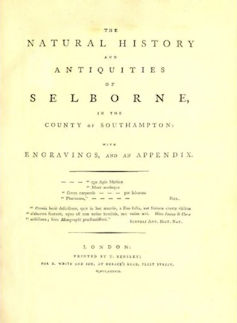
I bought a copy of this book as a biology undergraduate, about 45 years ago. Even now it is a great historical record of the development of ecology as a science. It has had more than 200 editions and is reputed to be – after the Bible, the works of Shakespeare and Pilgrim’s Progress – the fourth most published book in the English Language. It was published in 1789 and since then has never been out of print. It has been translated into numerous other languages, including a German version as early as 1794, and has also influenced a diverse group of writers, including Samuel Taylor Coleridge, Virginia Woolf, W H Auden, right up to Sir David Attenborough. The book consists of 110 letters spanning 20 years.
One such letter, to Barrington, dated May 20, 1777, specifically on the activities of earthworms is strikingly pertinent. He wrote:
Earthworms, though in appearance a small and despicable link in the chain of nature, yet if lost, would make a lamentable chasm. For, to say nothing of half the birds, and some quadrupeds, which are almost entirely supported by them …
This was in reference to their important place in food chains with carnivores, herbivores, omnivores and, in the case of worms, detritivores. As earthworm bodies are around 70% protein (much circular and longitudinal muscle used for movement), they fall prey to a host of birds; from blackbirds to tawny owls, and mammals, including moles, badgers, shrews, foxes, and even other invertebrates including predatory beetles and flatworms.
In the same letter, White continued:
… worms seem to be the great promoters of vegetation, which would proceed but lamely without them, by boring, perforating and loosening the soil, and rendering it pervious to rains and the fibres of plants, by drawing straws and stalks of leaves and twigs into it; and, most of all, by throwing up such infinite numbers and lumps of earth called worm-casts, which being their excrement is a fine manure for grain and grass.
It is quite remarkable that here, from writings of nearly 250 years ago, White refers to many activities of earthworms (burrow formation, dead organic matter incorporation, cast production and nutrient release) that we, as scientists and gardeners, now take for granted and utilise or continue to investigate in greater detail.
In many aspects, White was ahead of his time scientifically and was specifically a great observer of the natural world. He also realised that earthworms change the form of the land itself. As he continued: “Worms probably provide new soils for hills and slopes where the rain washes the earth away; and they affect slopes, probably to avoid being flooded.”
Here, White was referring to the larger scale change of landform that he conceived earthworms were able to affect.
Examining the soil by candlelight
In another (undated) letter to Pennant, White wrote:
Hedge-sparrows … in mild weather they procure worms, which are stirring every month in the year, as any one may see that will only be at the trouble of taking a candle to a grass plot on any mild winter’s night.
This showed that White even made observations in the dark and recorded earthworm behaviour at the soil surface (likely of Lumbricus terrestris, the lob worm or nightcrawler, which feeds and mates on the soil surface with its tail remaining in its burrow).
White must have also witnessed this mating behaviour and was aware of the hermaphroditic nature of worms, as he recorded:
Worms work most in the spring; but … are out every mild night in the winter, as any person may be convinced that will take the pains to examine his grass-plots with a candle; are hermaphrodites, and much addicted to venery [mating], and consequently very prolific.
White also wrote that “a good monography of worms would afford much entertainment and information at the same time and would open a large and new field in natural history”. He was so right, but it would be another century before such a book (Darwin’s Worms) appeared – and sadly, the importance of his own work would hardly be mentioned in it.
Crediting White’s discoveries
Darwin has been quoted as saying that he “stood on the shoulders” of White, and went on “a pilgrimage to Selborne” as a young man in June 1857.
And Darwin clearly referred to the work of White in Worms. For example, when discussing lob worm behaviour, he stated “… under ordinary circumstances healthy worms never, or very rarely, completely leave their burrows at night; but this is an error, as White of Selborne long ago knew”.
Nevertheless, Darwin did not give a full account of the many particular and relevant earthworm observations of White, relating to their ecosystem services and their vital roles in food chains and turnover of soil and behaviour at the soil surface.
This suggests that Darwin may not have wanted to acknowledge that someone had beaten him – by a century – to some very important earthworm-related scientific findings.
Other researchers have been even less kind when it comes to Darwin’s intentions.
In the 1941 Penguin edition of White’s Natural History, editor James Fisher wrote in a note to White’s letter to Barrington: “104 years after this letter was written, Darwin’s The Formation of Vegetable Mould, through the Action of Worms was published, and did indeed open a large and new field in natural history. Through some error (for he must have known of these wise observations of White) Darwin did not quote this letter, though it seems pretty certain that it must have been among the stimuli which caused him to take up his investigations of these interesting and valuable creatures.”
And in a paper specifically on “Gilbert White and Darwin’s worms”, the scientist Gerhard Cadee wrote: “I am more inclined to think Darwin purposely omitted White.”
A biography of Darwin also shows that, even as a student, he possessed a copy of White’s book (which, it must be remembered covered many aspects of natural history, not only earthworms). He used this to assist watching and identifying bird behaviours as he improved his ornithological skills.
The findings of both White and Darwin are now fully appreciated by earthworm ecologists, but I think the Hampshire clergyman deserves a bit more credit.
So, I believe it worth noting that White was the first to record that earthworms:
- Act as vital components in animal food chains
- Assist plant growth
- Create burrows in the soil for aeration and water infiltration
- Incorporate dead organic matter into the soil to increase fertility
- Produce castings and release nutrients
- Can be seen at night feeding and mating on the soil surface
I visited White’s home 20 years ago and even contemplated seeking permission to investigate earthworms there, but this would probably have added little to the story of his very early ecological observations. As a biologist, it is always a pleasure to be able to see the places where your scientific “heroes” once made their observations. Which was why it was such an honour to carry on the work of Darwin at Down House and incorporate the knowledge that both men handed down.
In Darwin’s footsteps
My own interest in earthworms began about a century after Darwin’s writing. In my PhD research, I looked at one species of earthworm (Lumbricus terrestris, the lob worm) and how this might be reared in large numbers for use in soil restoration schemes. This entailed controlled cultivation under laboratory conditions examining, for example, temperature effects and quality of food (organic waste materials) on growth rate and reproduction. This gave me a grounding in earthworm ecology and set me on a path of scientific research which I have followed throughout my career.
In 2004 I was lucky enough to be granted the opportunity to work in Darwin’s own garden at Down House. This was where he carried out many experiments over the 40 years he was there. It was such a thrill to work there; to follow in Darwin’s footsteps and feel a connection with his writing. Finding some of the places mentioned in Worms and discovering the locations described was wonderful.
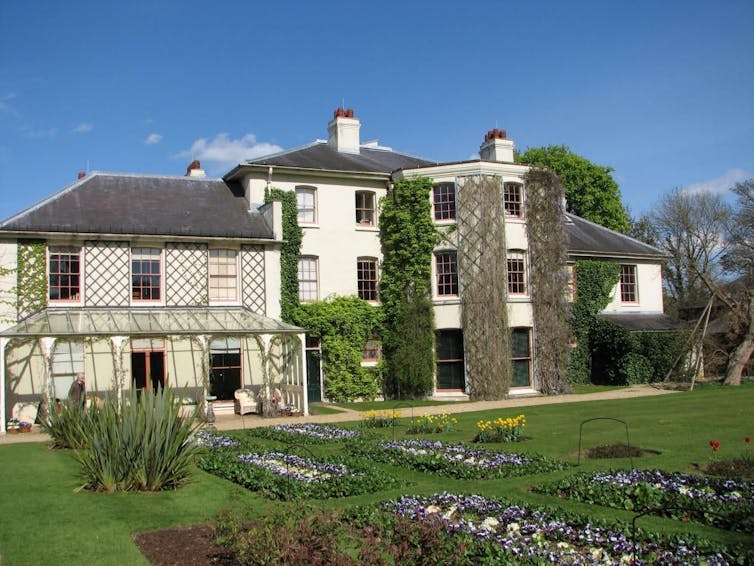
It is recorded in Worms that the Darwin family assisted with indoor research by shouting, playing the bassoon, metal whistle and piano to determine if earthworms were sensitive to sound. No reactions were recorded to these sounds, but when a pot of worms was placed on the piano and a note was struck, the worms withdrew into their burrows. Darwin showed that earthworms had no sense of hearing but were very sensitive to vibrations, a key predator-avoidance strategy.
One of Darwin’s major observations on his estate was in Great Puckland’s Meadow, a field last ploughed in 1841 and then left to pasture. He noted that initially it was thickly covered with small and large flints, “some of them half as large as a child’s head” and was a place his sons called “the stony field.” He remarked:
When they ran down the slope the stones clattered together, I remember doubting whether I should live to see these larger flints covered with vegetable mould and turf. But the smaller stones disappeared before many years had elapsed, as did every one of the larger ones after a time; so that after thirty years (1871) a horse could gallop over the compact turf from one end of the field to the other, and not strike a single stone with his shoes.
Darwin stated that: “To anyone who remembered the appearance of the field in 1842, the transformation was wonderful. This was certainly the work of the worms, for though castings were not frequent for several years, yet some were thrown up month after month, and these gradually increased in numbers as the pasture improved.”
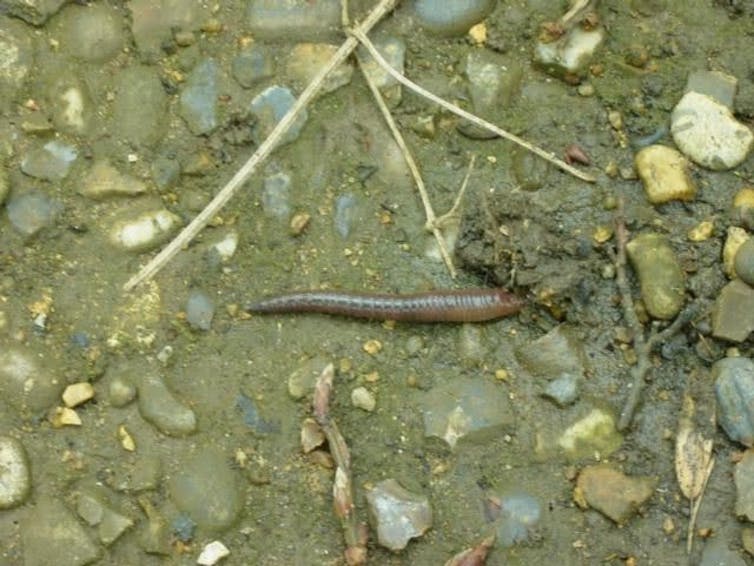
In 1871 Darwin measured the thickness of the turf (grass roots) and of the vegetable mould (earthworm casting). This was long-term ecological monitoring (LTEM), a hundred years before anyone had even thought of the term.
Repeating Darwin’s experiment
Reading these records of flint burial from Great Puckland’s Meadow led me to propose and set up further earthworm investigations at Down House. In 2007, wheelbarrows full of flints from a pile collected on the estate were roughly divided into large and small.
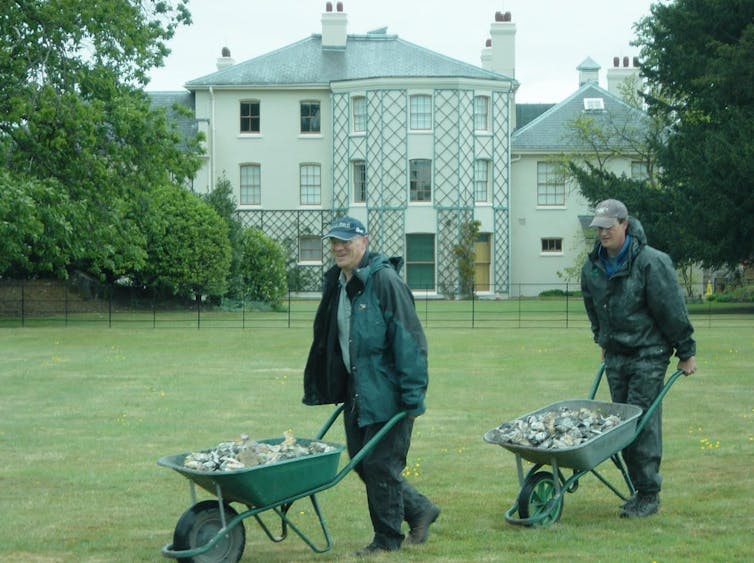
The flints were laid out on the soil surface in known locations in the centre of the field where they were unlikely to be disturbed and left for some years. Photographs were taken of each experimental square metre, so that individual flints could be recognised and followed over time. Managers of the site (English Heritage) agreed to avoid driving any mowers or other vehicles over the flints. We have returned to the site three times to date (2013, 2017 and 2021), and on each occasion excavated a quarter of each square metre.
Every time I return to Down House I still get the same buzz as when I first worked there. I almost have to pinch myself and focus on the work required, as it is still almost unbelievable that I am able to do this research.
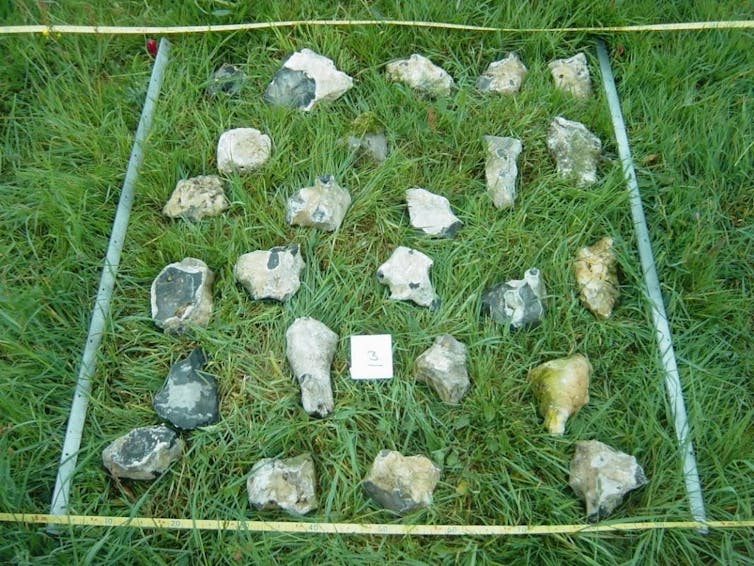
Images and records of stone position, relative to the soil surface, show that burial of the flints, as observed by Darwin, is taking place. We aim to continue this research so that a comparable set of data can be collected to that presented by Darwin.
Our most recent sampling (2021) was 150 years after the measurements taken by Darwin and 140 years since publication of Worms. When we next return it will also be around 250 years since the writings of White.
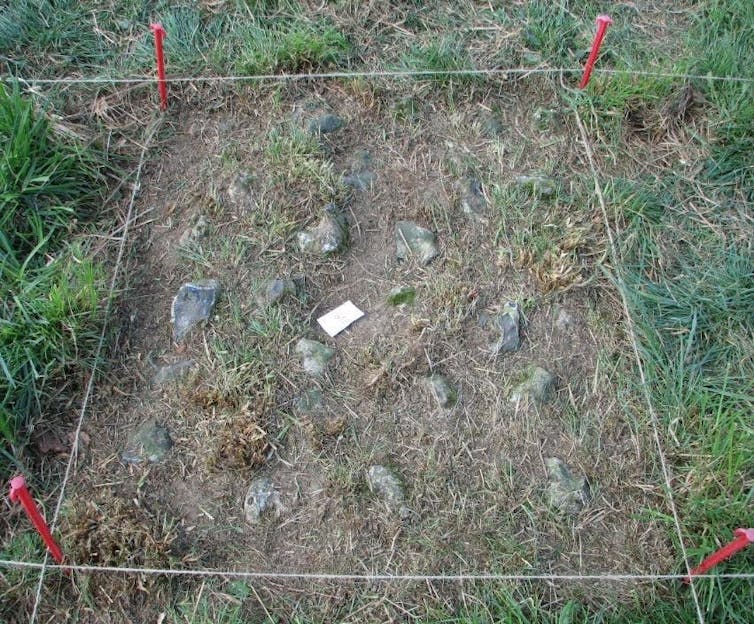
From pests to soil saviours
Today, most of us regard earthworms as an asset in soils, but until the early 19th century, they were regarded as pests. A gardening encyclopaedia stated that, “Of worms … there are only a few genera which are materially injurious in gardens, the earthworm, the slug, and the snail”.
Gardeners assigned earthworms to a group of noxious creatures, as it was thought that they ate the roots of cultivated plants. This advice was followed more directly with: “The earth-worm is most effectually kept under by watering with lime water … the ground infested with worms should have their casts scraped off, and then the water should be applied from the rose of a watering pot”.
White however, knew better and separated worms from slugs and snails. In a letter to Barrington in May 1777, he wrote:
Gardeners and farmers express their detestation of worms; the former because they render their walks unsightly, and make them much work: and the latter because, as they think, worms eat their green corn. But these men would find that the earth without worms would soon become cold, hard-bound, and void of fermentation.
Darwin is rightly lauded as a scientific giant for his many influential and inspirational discoveries. But when it comes to worms and soil ecology, Gilbert White deserves to be part of the conversation. We owe much to the work of them both for beginning our scientific interest in these humble creatures upon which so much relies.

For you: more from our Insights series:
To hear about new Insights articles, join the hundreds of thousands of people who value The Conversation’s evidence-based news. Subscribe to our newsletter.
Kevin Richard Butt, Reader in Ecology, University of Central Lancashire
This article is republished from The Conversation under a Creative Commons license. Read the original article.










